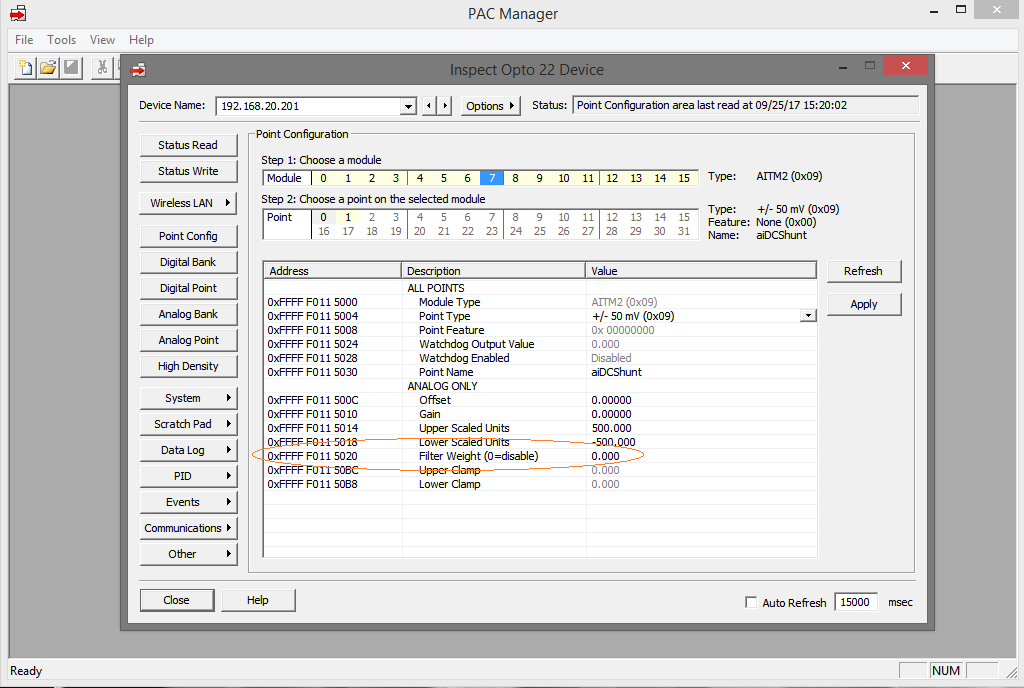The noise levels you’re seeing are not a huge percentage of the full signal range, but ideally, you may be able to do better.
Also, since you’re seeing this noise with everything disconnected except a current loop calibrator, a lot of what follows may be of no use to you at all, but then again, it might.
We also have to consider whether or not the current loop calibrator puts out a good, clean signal itself.
I’d be curious to see what the readings are from the input modules when you short each of their inputs out with short jumper wires. This will give you zero mA, but if you read the raw data, since these modules read from -20 to +20mA, you can observe the fluctuations in the raw data right near zero even though that’s below the bottom of your scaled range.
I’m just tossing all of this out there as some other things to consider:
What sort of power supply are you using to run the SNAP-PAC-RCK? I’ve found that you need to use a good, clean power supply, and it helps to have it set up to provide a bit more than 5 Volts. 5.20 Volts is often better. Power supply noise is always a consideration.
Assuming that the problem is not (or not entirely) from the SNAP-PAC AIMA-8 itself, then:
When you have multiple transducers connected to non-isolated inputs, you are, in effect connecting the commons of all of these transducers as well as their wiring together. So shielding and attention to ground loops becomes very important.
At the very low signal levels we’re talking about, it would not be surprising to see noise and ground-loop issues showing up when tying the four transducers and their wiring together this way.
Are these transducers near to, or far from the Opto 22 system input module? In other words, do you have long wire runs?
Are the 4-20mA outputs of the transducers isolated from the “process connections” of the transmitters?
Are these 2-Wire transmitters or self-powered transmitters? And if they’re 2-Wire units, do they share a common loop power supply?
Does the signal wiring run near to, and worst of all, parallel to, any high-power wiring?
Great care must me taken when designing and connecting a system like this, especially when using non-isolated 4-20mA inputs. So much so, that I almost never use anything but isolated inputs or I install separate signal isolators.
It would be very easy to end up with ground loops between transducers if they are not electrically isolated from each other.
Also, proper shielding and grounding practice is often overlooked. I prefer to use shielded twisted pair cable for transducers. Then, a simple rule that is (almost) always true is that you should tie the shield (drain) wire of the shielded twisted pair ONLY at the receiving end of the run. That means leaving it disconnected (and insulated off) at the transducer/transmitter end, and tying it to the “signal low” end at the input module (if it’s an isolated module) or to the low-side common if it is a non-isolated input module. But again, I really don’t like using non-isolated input modules.
You can use the best, most accurate pressure transmitters in the world, and still end up with noise if the wiring, grounding, shielding, and isolation are not done with great care. The loop supply(s) and how they’re connected are also important.
It may well be true that the 8-channel non-isolated current input module is inherently more noisy than the 2-channel unit.
And if the current simulator and “shorted input” tests bear that out, then there’s not much to be done other than switch to using the lower channel-count input modules.
But I’d also always recommend that people use isolated input modules like the SNAP-AIMAi, especially if they’re trying to get the absolute lowest noise, which I think you are in this case.
Noise pick-up in this kind of system can be a source of great frustration. But using isolated input modules and observing proper shielding and grounding techniques can eliminate virtually all such problems.
That was long and boring, but perhaps there is something in there that might help a bit.

